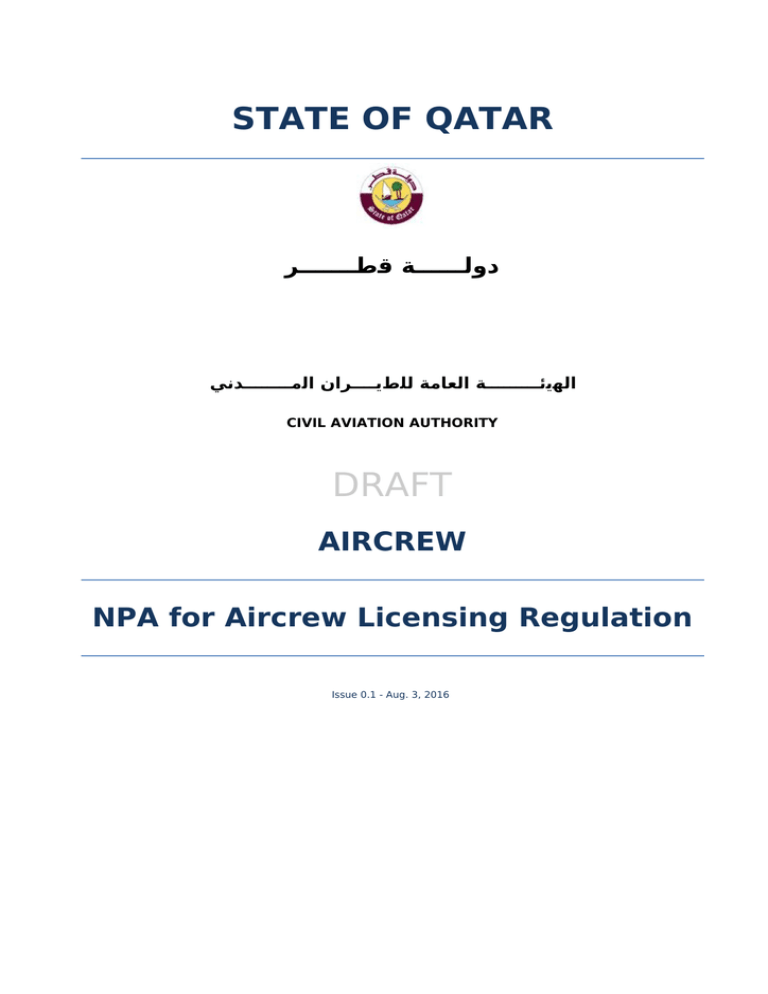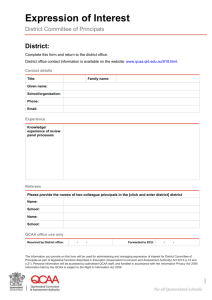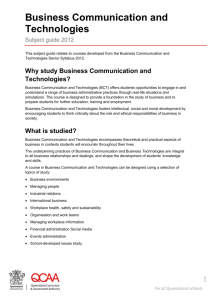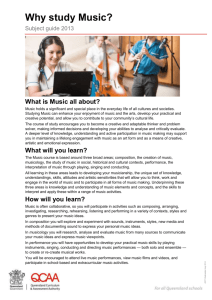
STATE OF QATAR
د و ﻟــــــ ﺔ ﻗ ﻃـــــــ ﺮ
اﻟ ﮭﯾﺋـــــــــ ﺔ اﻟ ﻌﺎ ﻣ ﺔ ﻟﻠ طﯾــــ ﺮا ن اﻟ ﻣــــــــ ﺪﻧ ﻲ
CIVIL AVIATION AUTHORITY
DRAFT
AIRCREW
NPA for Aircrew Licensing Regulation
Issue 0.1 - Aug. 3, 2016
NPA RSRP.002/10
Table of Contents
1. Procedural information
1.1 The rule development procedure
1.2 The structure of this NPA and related documents
1.3 How to comment on this NPA
1.4 The next steps in the procedure
2. Explanatory Note
2.1 Overview of the issues to be addressed
2.2 Objectives
2.3 Overview of the proposed Aircrew regulations .
3. Proposed amendments
4. Proposed New Regulations
5. References
5.1 Affected regulations
5.2 Affected CS, AMC and GM
5.3 Reference documents
TE.RMP.00034-004 © Civil Aviation Authority of the State of Qatar. All rights reserved.
Proprietary document. Copies are not controlled. Confirm revision status through the QCAA-Internet/Intranet.
6
6
6
6
7
7
7
7
7
9
9
9
10
10
10
Page 2 of 10
NPA RSRP.002/10
Qatar Civil Aviation Regulations (Aircrew Licensing)
RSRP.002/10— 01/08/2016
Executive Summary
Issue of Regulations providing Formal Requirements and Standards, Acceptable Means
of Compliance and Guidance Material relating to:
Aircrew Licensing
The Qatar Civil Aviation Authority, under the Regulatory Structure and Regulations Program, is in
the process of restructuring its regulatory framework and aligning its operating regulations with
that of the EASA regulations.
The Objectives of the Qatar Civil Aviation Authority are specified in Emiri Decree 45 of 2014 and
amongst others, are to attain best standards and competencies and ensure civil aviation safety in
matters related to air transportation.
This Notice of Proposed Amendment (NPA) is issued in line with the QCAA Rulemaking process
under QCAR 11.
This NPA introduces QCAR Aircrew Licensing which contains the formal Requirements and
Standards as well as the Acceptable Means of Compliance (AMC), and Guidance Material (GM)
relating to licensing and medical certification of Aircrew and the related Acceptable Means of
Compliance (AMC) and Guidance Material (GM).
This NPA proposes the following, amongst others:
Main changes for organisations providing training for Aircrew licensing ie: requirement for all
organisations to be approved and certified by the QCAA in accordance with ICAO Annex 1
and similar requirements to that of EU regulation 1178.
new forms of licences
The development of a non-ICAO licence called Light Aircraft Pilot Licence (LAPL)
The introduction of a Flight Examiners certificate.
With the introduction of the new kind of licences/attestation in the recreational areas and for
cabin crew, changes have been introduced in the medical areas
QCAR Aircrew Licensing shall replace QCAR FCL 1, QCAR FCL 2 and QCAR MED.
The proposed changes are expected to ensure compliance with ICAO standards and improve
harmonisation within the industry.
The proposed Regulation Aircrew Licensing shall enter into force on 1st October 2016 and it is
expected that full implementation and mandatory compliance will be attained by 30th September
2017.
TE.RMP.00034-004 © Civil Aviation Authority of the State of Qatar. All rights reserved.
Proprietary document. Copies are not controlled. Confirm revision status through the QCAA-Internet/Intranet.
Page 3 of 10
NPA RSRP.002/10
Applicability
Process map
QCAR FCL 1
Affected regulations
and decisions:
QCAR FCL 2
QCAR MED
Affected stakeholders:
Driver/origin:
Reference:
QCAA/ Industry
RSR Program
RSRP002/10
Concept Paper:
No
Terms of Reference:
RSRP WP 1
Rulemaking group:
No
RIA type:
None
Technical consultation
during NPA drafting:
Yes
Duration of NPA consultation:
1 month
Review group:
Yes
Focused consultation:
Yes
Publication date of the QCAR:
1st October 2016
TE.RMP.00034-004 © Civil Aviation Authority of the State of Qatar. All rights reserved.
Proprietary document. Copies are not controlled. Confirm revision status through the QCAA-Internet/Intranet.
Page 4 of 10
NPA RSRP.002/10
Managerial guidance (for internal use)
Contributors (for internal use; adjust as appropriate)
Name
Version No Date
Prepared by:
Ole Boysen Lynggaard
0.1
Peer-reviewed by:
Name
review coordinated by:
Ray Elgy
Reviewed by:
Name
Approved by:
Regulatory Review Steering Committee
Proofreading completed by:
Name
TE.RMP.00034-004 © Civil Aviation Authority of the State of Qatar. All rights reserved.
Proprietary document. Copies are not controlled. Confirm revision status through the QCAA-Internet/Intranet.
28/JUL/2016
Page 5 of 10
NPA RSRP.002/10
Table of contents
1. Procedural information 4
a. The rule development procedure 4
b. The structure of this NPA and related documents 4
c. How to comment on this NPA 4
d. The next steps in the procedure 4
2. Explanatory Note 5
a. Overview of the issues to be addressed 5
b. Objectives 5
c. Overview of the proposed Aircrew regulations. 5
3. Proposed amendments 7
a. Proposed New Regulations 7
4. References 7
a. Affected regulations 7
b. Affected CS, AMC and GM 8
c. Reference documents 8
1. Procedural information
1.1 The rule development procedure
The Qatar Civil Aviation Authority (hereinafter referred to as the ‘QCAA’) developed this Notice of
Proposed Amendment (NPA) in line with Article 4 of Law no. 15 of 2002 as amended, (hereinafter
referred to as Law 15) and the QCAR 11 Rulemaking Procedure.
This rulemaking activity is included in the QCAA’s Regulatory Structure and Regulations Programme
2016 – 2018.
The text of the proposed regulation in Annex 1 has been developed by the QCAA as part of the
rulemaking process and procedure specified in QCAR 11. It is hereby submitted for consultation of
the aviation industry.
1.2 The structure of this NPA and related documents
Chapter 1 of this NPA contains the procedural information related to this task. Chapter 2
(Explanatory Note) explains the core technical content. Annex 1 contains the proposed text for the
new requirements.
1.3 How to comment on this NPA
Please submit your comments to RSRProgram@caa.gov.qa .
TE.RMP.00034-004 © Civil Aviation Authority of the State of Qatar. All rights reserved.
Proprietary document. Copies are not controlled. Confirm revision status through the QCAA-Internet/Intranet.
Page 6 of 10
NPA RSRP.002/10
The deadline for submission of comments is 28 August 2016.
1.4 The next steps in the procedure
Following the closing of the NPA Industry consultation period, the QCAA will review all comments
and undertake a focused consultation with Stakeholders.
The outcome of the NPA industry consultation as well as of the focused consultation will be
reflected in the respective Comment-Response Document (CRD).
The QCAA will publish the CRD with the QCAR.
2. Explanatory Note
To ensure that the State of Qatar fulfils its ICAO Obligations and meets the highest standards in
order to facilitate the growth of the aviation sector, the QCAA has undertaken to align its regulatory
framework and regulations with the EU/EASA framework and regulations where applicable.
2.1 Overview of the issues to be addressed
The restructuring of the QCAA Regulatory framework allows for the adaptation of applicable EASA
regulations incorporating ICAO Standards and will enable the implementation of similar regulatory
approaches.
2.2 Objectives
The overall objectives of the QCAA are defined in Article 4 of Emiri Decree 45 of 2014. This
proposal will contribute to the achievement of the overall objectives by addressing current
amendments to the ICAO annexes and aligning with current EASA regulations where applicable.
2.3 Overview of the proposed Aircrew regulations .
A . General
The purpose of this Notice of Proposed Amendment (NPA) is to seek opinions from industry on the
proposed regulations for the licensing and medical certification of Aircrew and the related
Acceptable Means of Compliance (AMC) and Guidance Material (GM).
B. The main changes for organisations providing training of Aircrew.
The main changes for organisations providing training for Aircrew licensing, is the requirement for
all organisations to be approved and certified by the QCAA in accordance with ICAO Annex 1 and
similar requirements to that of EU regulation 1178/2011 as amended.
All certified organisations must have a Safety Management System (SMS). This system should be
tailored to the activity and complexity of the organisation.
All certified organisations must have approved documentation for their activity such as Operations
Manual and Training manual.
Also Medical Centres (AeMC) shall be certified as above and be included within the QCAA’s
oversight programme.
Organisations providing training of Cabin Crew shall be approved by the Authority.
C. The main changes with regard to Aircrew training and licensing:
As far as possible the new regulations are developed from the EU regulation 1178/2011, which was
TE.RMP.00034-004 © Civil Aviation Authority of the State of Qatar. All rights reserved.
Proprietary document. Copies are not controlled. Confirm revision status through the QCAA-Internet/Intranet.
Page 7 of 10
NPA RSRP.002/10
based on the JAR-FCL 1, 2, 3 and 4. In addition, the implementing rules take account of ICAO Annex
1.
In the case of Flight Engineers, no new requirements have been developed due to the fact that for
the time being, no such training is taking place and no Flight Engineer licences have been issued by
QCAA. Furthermore, such licences will likely only be required for historic aircraft types. Should there
be a request for such licences, the QCAA will issue them in accordance with the requirements
prescribed in JAR-FCL 4 unless new regulations for Flight engineers are developed in the meantime.
The draft regulations also include new forms of licences.
A non-ICAO licence has been developed called the Light Aircraft Pilot Licence (LAPL). The
background for this new licence was to adapt the system accepted within the EU. As a non-ICAO
licence it is restricted for use only within the State of Qatar but allows pilots to operate certain light
aircraft under a lighter and proportionate regulatory framework. For these licences there are
restrictions for operations with respect to the maximum certified take off mass and number of
persons that may be carried on board. There are also reduced medical requirements. These LAPL
licences can be issued for either LAPL(Aeropolane), LAPL (Sailplane), or LAPL(Balloons).
For Private Pilot Licences new requirements have been introduced to address the following amongst
others:
PPL holders can receive remuneration for exercising their Flight Instructor privileges for provision of
flight instruction for LAPL or PPL.
The conduct of skill tests and proficiency checks for these licences;
The training, testing and checking for the ratings or certificates attached to this licence.
Night rating
The background for this is to harmonise the activities taking place globally.
A new licence for Airships has been introduced.
With these new regulations, the Flight Examiners certificate is introduced. That means that a
certificate replaces an authorisation. With this change the Flight Examiners will not in future work
on behalf of the Authority. That means that the Authority will develop an Examiner Monitoring
system as prescribed in the Part ARA.
The following new ratings are introduced:
Sea rating.
Mountain rating.
Sailplane towing.
Banner towing rating.
Flight test rating.
En route instrument rating (EIR).
Sailplane Cloud Flying Rating.
With these new developed regulations there are also requirements for Cabin Crew. After finishing
the initial training course, the applicant shall be issued with an attestation. This cabin Crew
Attestation shall be issued:
TE.RMP.00034-004 © Civil Aviation Authority of the State of Qatar. All rights reserved.
Proprietary document. Copies are not controlled. Confirm revision status through the QCAA-Internet/Intranet.
Page 8 of 10
NPA RSRP.002/10
(1) by the Authority; and/or
(2) by an organisation approved to do so by the Authority.
D . The main changes for Medical certification.
With the introduction of the new kind of licences/attestation in the recreational areas and for cabin
crew, changes have been introduced in the medical areas.
For the LAPL system there is now the possibility of using a General Medical Practitioner (GMP) as
medical examiner if national law allows. The medical requirements for LAPL applicants are not as
demanding as for a medical certificate class 2.
For the Cabin Crew it will be possible to use an Occupational Health Medical Practitioner (OHMP).
The requirements for Cabin Crew medical certification are not as demanding as for medical class
2.
For Aeromedical Examiners there is now a requirement to be certified by the Authority and not
authorised.
E. The main changes for the QCAA
With respect to the QCAA, there are defined requirements for establishing a Management system
including policies and procedures.
There are also specific requirements to establish oversight programmes.
The Authority for oversight shall have a system to analyse findings for their safety significance.
3. Proposed amendments
This Regulation is intended to replace QCAR FCL 1, QCAR FCL 2 and QCAR MED. As such there are
no amendments contained within the text.
4. Proposed New Regulations
This NPA reflects the QCAA Aircrew Regulation which is supported by seven Annexes that contain
detailed Implementing Rules as follows:
• Annex I Part-FCl
• Annex II to be reserved
• Annex III Third Country License (TCl) Conversion and Validation
• Annex IV Part-MED
• Annex V Part Cabin Crew
• Annex VI Part-ARA (Authority Requirements for Aircrew)
• Annex VII Part-ORA (Organisation Requirements for Aircrew)
Upon its full implementation, QCAA Aircrew Regulation will replace current QCAR FCL1, FCl2 and
QCAR MED and a number of current publications issued by QCAA in the form of
Information leaflets (Ils).
AMCs are also to be published alongside the QCAR.
5. References
TE.RMP.00034-004 © Civil Aviation Authority of the State of Qatar. All rights reserved.
Proprietary document. Copies are not controlled. Confirm revision status through the QCAA-Internet/Intranet.
Page 9 of 10
NPA RSRP.002/10
5.1 Affected regulations
QCAR FCL 1,
QCAR FCL 2
QCAR MED
5.2 Affected CS, AMC and GM
Nil
5.3 Reference documents
ICAO Annex 1
EU regulation 1178
TE.RMP.00034-004 © Civil Aviation Authority of the State of Qatar. All rights reserved.
Proprietary document. Copies are not controlled. Confirm revision status through the QCAA-Internet/Intranet.
Page 10 of 10



